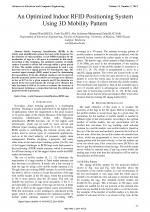| 2/2014 - 4 |
An Optimized Indoor RFID Positioning System Using 3D Mobility PatternREZA, A. W. |
| Extra paper information in |
| Click to see author's profile in |
| Download PDF |
Author keywords
radio frequency identification, RFID tags
References keywords
rfid(12), localization(9), research(6), progress(6), electromagnetics(6), mobile(5), indoor(5), utilizing(4), tracking(4), robotics(4)
Blue keywords are present in both the references section and the paper title.
About this article
Date of Publication: 2014-05-31
Volume 14, Issue 2, Year 2014, On page(s): 23 - 28
ISSN: 1582-7445, e-ISSN: 1844-7600
Digital Object Identifier: 10.4316/AECE.2014.02004
Web of Science Accession Number: 000340868100004
SCOPUS ID: 84901825025
Abstract
Radio frequency identification (RFID) is the widely used identification system that uses radio frequency for the detection of object position. A new RFID technique for the localization of tags in a 3D space is presented in this study. According to this technique, the optimized number of mobile readers is needed to afford full coverage within a given period of time. The mobile readers are programmed in such a way that they move in a zigzag pattern for detecting the tags. The received signal strength (RSS) model is used for determining the tag positions. From the obtained results, it can be observed that the proposed model can achieve an average error distance as low as 0.27 m for a given scenario and if the obstacles are placed in the test environment, the average error distance has only increased to 0.38 m. In order to evaluate the accuracy of the proposed technique, a comparison between the existing and proposed model is presented. |
| References | | | Cited By |
Web of Science® Times Cited: 2 [View]
View record in Web of Science® [View]
View Related Records® [View]
Updated 2 weeks, 5 days ago
SCOPUS® Times Cited: 2
View record in SCOPUS® [Free preview]
View citations in SCOPUS® [Free preview]
[1] Stochastic Wheel-Slip Compensation Based Robot Localization and Mapping, SIDHARTHAN, R. K., KANNAN, R., SRINIVASAN, S., BALAS, V. E., Advances in Electrical and Computer Engineering, ISSN 1582-7445, Issue 2, Volume 16, 2016.
Digital Object Identifier: 10.4316/AECE.2016.02004 [CrossRef] [Full text]
[2] Factors Affecting Self-Localization in UHF RFID Tag Networks, Shmaliy, Yuriy, Khan, Sanowar, Ibarra-Manzano, Oscar, Zhao, Snunyi, EQUATIONS, ISSN , Issue , 2021.
Digital Object Identifier: 10.37394/232021.2021.1.11 [CrossRef]
[3] A centralized architecture for inventory management using RFID, Zohaib, Muhammad, Pasha, Syed Mustafa, Hassan, Zeeshan, Iqbal, Jamshed, 2016 2nd International Conference on Robotics and Artificial Intelligence (ICRAI), ISBN 978-1-5090-4059-9, 2016.
Digital Object Identifier: 10.1109/ICRAI.2016.7791239 [CrossRef]
Disclaimer: All information displayed above was retrieved by using remote connections to respective databases. For the best user experience, we update all data by using background processes, and use caches in order to reduce the load on the servers we retrieve the information from. As we have no control on the availability of the database servers and sometimes the Internet connectivity may be affected, we do not guarantee the information is correct or complete. For the most accurate data, please always consult the database sites directly. Some external links require authentication or an institutional subscription.
Web of Science® is a registered trademark of Clarivate Analytics, Scopus® is a registered trademark of Elsevier B.V., other product names, company names, brand names, trademarks and logos are the property of their respective owners.
Faculty of Electrical Engineering and Computer Science
Stefan cel Mare University of Suceava, Romania
All rights reserved: Advances in Electrical and Computer Engineering is a registered trademark of the Stefan cel Mare University of Suceava. No part of this publication may be reproduced, stored in a retrieval system, photocopied, recorded or archived, without the written permission from the Editor. When authors submit their papers for publication, they agree that the copyright for their article be transferred to the Faculty of Electrical Engineering and Computer Science, Stefan cel Mare University of Suceava, Romania, if and only if the articles are accepted for publication. The copyright covers the exclusive rights to reproduce and distribute the article, including reprints and translations.
Permission for other use: The copyright owner's consent does not extend to copying for general distribution, for promotion, for creating new works, or for resale. Specific written permission must be obtained from the Editor for such copying. Direct linking to files hosted on this website is strictly prohibited.
Disclaimer: Whilst every effort is made by the publishers and editorial board to see that no inaccurate or misleading data, opinions or statements appear in this journal, they wish to make it clear that all information and opinions formulated in the articles, as well as linguistic accuracy, are the sole responsibility of the author.



